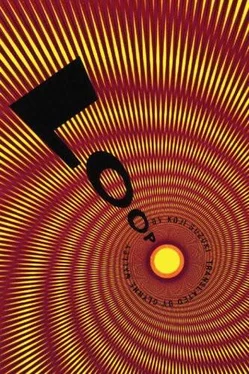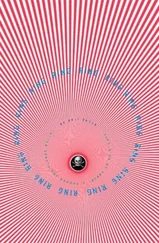Amano stopped fast-forwarding at an appropriate place and pressed PLAY.
"There. Now it gets into the aims of the Loop research."
Hideyuki's face was onscreen now. Kaoru felt a tightening in his chest as he saw his father's youthful countenance-this had been filmed not long after his marriage. His hair was still thick, his whole being suffused with passion and confidence. The firmness of his muscles was evident even through his clothing.
Come to think of it, this was the first time Kaoru had seen video of his father from before Kaoru's birth. He hadn't been expecting it-it was surprise as much as anything that shook him.
The image changed to a vast desert in America, to a superconducting super accelerator some thirty miles in diameter, part of a project long since abandoned. Aerial shots showed the exterior, and then the scene cut to the interior. The huge ring-shaped research facility, once a useless hulk, was now filled, the video revealed, with a huge number of massively parallel supercomputers. The numbers were incredible. Six hundred and forty thousand computers buried beneath the desert sand: a truly overwhelming sight.
Then the scene made another abrupt shift, this time to the skyscrapers of Tokyo. The camera went underground again, into a maze of abandoned subway tunnels branching out like a spider's web. Here, too, were installed 640,000 massively parallel supercomputers. Underground, where the humidity was low and the temperature was relatively constant year-round, was the ideal place for the computers.
This joint Japanese-American collection of massively parallel supercomputers-a staggering 1.28 million in all-was there to sustain the Loop.
Hideyuki reappeared onscreen. Having shown off the hardware that drove the Loop, it was time to explain the software.
Hideyuki pointed to a computer screen and narrated in precise, well-chosen words while the process of cellular division was demonstrated through symbols. The Hideyuki Kaoru knew was inclined to speak quickly and animatedly, but the Hideyuki on the video averted his eyes from the camera and spoke somewhat shyly, although not without confidence.
Kaoru already understood what Hideyuki was explaining now. Although it had been research in progress then, from a standpoint twenty years on, it was fairly easy to comprehend. But what was their methodology? These were the first detailed images Kaoru had seen of the project, and his interest was captured.
The monitor Hideyuki was pointing at showed the development of the cell of some organism, and next to it the same process recreated artificially and represented symbolically. A natural cell and a man-made one, side by side. Over time, they both took roughly the same shape. The process by which the real organism formed was translated into symbols and manifested in the computer simulation. Upon the incorporation of various algorithms, the shape of an organism appeared on the monitor.
The idea behind the Loop project, a joint Japan — U.S. undertaking, had been to create life within the virtual space of the computers, pass on DNA from generation to generation, and incorporate the mechanisms of mutation, parasitism, and immunity, thereby to create an original biosphere to simulate the evolution of life on earth. In short, to create another world exactly like the real one, on computers.
At this point, Amano paused the videotape and turned to Kaoru.
"Do you have any questions thus far?"
"Well," Kaoru spoke up. "What field, exactly, was this research supposed to be useful to?" This had been nagging at him for some time. Where did the funding come from? What kind of practical application would this research have had?
Judging by what he'd seen, the budget was probably big enough to require government support. Solving the riddles of life on earth, the mechanism of evolution, would be sure to satisfy academic curiosity, but he doubted it'd make money for anybody.
"We were taking the long view. We knew that at first it would be of only limited use. But once we opened up the field, there was no telling what kind of developments would pop up later. The number of possible applications was literally infinite. Fields like medicine and physiology for starters, but also microbiology, physics, meteorology… And not just science: we expected it to have implications for everything from understanding movements in stock prices to figuring out social-science problems such as population increases."
Amano paused and laughed.
In fact, the fruits of the Loop research had proven useful on a wide variety of fronts. It became possible to know the point at which earth's environmental and ecological balance would be destroyed, allowing for the development of management strategies; there were epochal advances in the study of at what point in the brain's development consciousness appeared. The contribution to medicine was huge, as treatments for several serious illnesses came to light.
The rest of the video was spent mostly on methodology. Hideyuki used diagrams to explain how through the application of chaos theory, nonlinearity, L-systems, genetic algorithms, and the like, the program was able to learn and evolve.
As an example, fragmentary images of cellular division were interspersed into the narrative. A shot of a cell dividing and redividing until it grew into an organism pulsated its way across the screen as if on fast-forward. The network developed dynamically, rather like a cancer cell growing capillaries. Even though Kaoru knew it was a mechanical simulation, it looked remarkably alive.
Having concluded its explanation of the methodology and thus its introduction to the project, the video ended with an invitation to the viewer to follow the real-life progress of the experiment.
Kaoru found it a pretty convincing promo.
Creating a computer simulation of the beginning and evolution of life wasn't a particularly unusual thing: it had been done several times in several different places. What amazed Kaoru was the scale of this project: the minute level of detail, the innumerable parameters that had been fed into the program. He figured it had to be the first time anything like it had been attempted.
What the experiment did was to take the some four billion years since life had begun and compress them into an accessible digital time frame. Billions of years had been abbreviated on the computers into ten or so years of real time, while still perfectly recreating in the virtual space the complexity of the real world.
Kaoru was curious about the subsequent progress of the research.
"How far did the Loop go?" he asked Amano, who was rewinding the tape.
"Didn't Futami-sensei tell you?"
"He told me that the pattern turned cancerous, that's all."
Amano looked troubled. "Well, that's about the size of it."
"I'd like to know more about the sequence of events, though."
"I'm sure you realize that even if you had the time to look at it, your life would end long before you finished."
Kaoru sighed intentionally.
"Okay, why don't we move to a different room and talk over coffee? I'd like to hear more about your father's condition, actually."
Amano led Kaoru into a larger but drearier room that looked like it was used for meetings or training sessions. It contained steel desks and folding chairs, and instead of modern art the walls held a map of the world; all in all it was an unremarkable room, sort of like a school classroom in miniature.
They sat at a table facing each other, and from nowhere appeared the receptionist to place cups of coffee in front of each of them.
It looked hot, at least: steam rose from the disposable cups. Amano wrapped both hands around his cup and brought it to his mouth. This room was windowless, too, and the air conditioning was turned up too high. Up to now Kaoru had been so wrapped up in what he was hearing that he'd been oblivious to the cold inside the centre. As he watched Amano take advantage of the warmth of the coffee Kaoru finally noticed that his own arms had goose-bumps from the cold.
Читать дальше
Конец ознакомительного отрывка
Купить книгу






![Yuriy Ktitorov - Sasha [Love]. Part 1](/books/459553/yuriy-ktitorov-sasha-love-part-1-thumb.webp)





